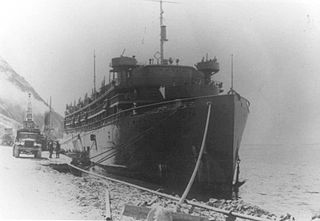
Dorchester was a coastal passenger steamship requisitioned and operated by the War Shipping Administration (WSA) in January 1942 for wartime use as a troop ship allocated to United States Army requirements. The ship was operated for WSA by its agent Atlantic, Gulf & West Indies Steamship Lines (Agwilines). The ship was in convoy SG 19 from New York to Greenland transiting the Labrador Sea when it was torpedoed by a German U-boat on February 3, 1943. The ship sank with loss of 674 of the 904 on board with one of the 230 survivors lost after rescue. The story of four Army chaplains, known as the "Four Chaplains" or the "Immortal Chaplains," who all gave away their life jackets to save others before they died, gained fame and led to many memorials.

USS Lyon (AP-71) was a type C3 ship of the United States Navy which played an extensive role in naval transportation during World War II. The Lyon was built as Mormactide under a Maritime Commission (MC) contract by the Ingalls Shipbuilding Company of Pascagoula, Mississippi. She was laid down 21 August 1939, and was launched on 12 October 1940; sponsored by Gloria McGehee.
USS Florence Nightingale (AP-70) was a Maritime Commission type C3-M cargo ship built as Mormacsun for Moore-McCormack Lines. Mormacsun operated for Moore-McCormack from May 1941 until December 1941 when she came under the War Shipping Administration (WSA) for the duration of World War II. The ship operated with Moore-McCormack as the WSA agent, playing an important role in early supply of the Southwest Pacific, until transfer to the United States Navy September 1942 and commissioning as Florence Nightingale whereupon she became an Elizabeth C. Stanton-class transport ship. She was named for Florence Nightingale (1820–1910), the nursing pioneer, and is one of the few United States Navy ships named after a woman. The ship was returned to WSA in 1946 and then to Moore-McCormack operating as Mormacsun until sold to operate as Japan Transport and lastly as Texas.

USS Arthur Middleton (AP-55/APA-25) was the lead ship of the Arthur Middleton-class attack transports and was in service with the United States Navy from 1942 to 1946. She was named for Founding Father Arthur Middleton and was scrapped in 1973.

The War Shipping Administration (WSA) was a World War II emergency war agency of the US government, tasked to purchase and operate the civilian shipping tonnage the United States needed for fighting the war. Both shipbuilding under the Maritime Commission and ship allocation under the WSA to Army, Navy or civilian needs were closely coordinated though Vice Admiral Emory S. Land who continued as head of the Maritime Commission while also heading the WSA.

MS Klipfontein was a Dutch ocean liner launched in March 1939 and delivered 29 July intended for South African service. Declaration of war in Europe, including Britain and South Africa declaring war on Germany, resulted in the ship being transferred to service between the Dutch East Indies and the west coast of North America. After the German invasion of the Netherlands in May 1939, with the Dutch government in exile in London, the ship supported the Allied war effort. After entry of the United States into the war the ship was operated by Dutch agents of the U.S. War Shipping Administration (WSA) from February 1942 to February 1946 as a troopship from the U.S. West Coast to Pacific war zones.
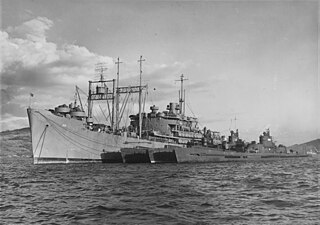
USS Euryale (AS-22) was built as the Hawaiian Merchant by the Federal Shipbuilding and Drydock Company in Kearny, New Jersey for the Matson Navigation Company. Hawaiian Merchant was launched 12 April 1941, minutes after sister ship Hawaiian Shipper, and was completed April 1941. Matson intended the ship to join Hawaiian Planter and Hawaiian Shipper in the U.S. Pacific Coast—Australia route. The ship was under United States Army Transportation Corps charter when the United States went to war and came under the control of the War Shipping Administration which allocated the ship to the Army's continued charter until the ship was purchased 15 April 1943 by the United States Navy and commissioned 2 December 1943 as USS Euryale (AS-22), serving as a submarine tender through the war. Euryale was decommissioned 7 October 1946, going into reserve until 9 August 1972 when she was delivered to the Maritime Administration with immediate sale to American Ship Dismantler, Inc. for disposal.

USS Mizar (AF-12) was the United Fruit Company fruit, mail and passenger liner Quirigua that served as a United States Navy Mizar-class stores ship in World War II.
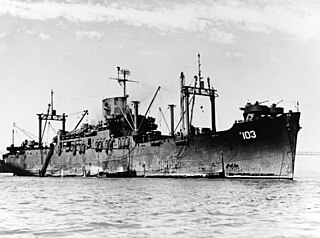
USS President Polk (AP-103) was a President Jackson-class attack transport in the service of the United States Navy during World War II.
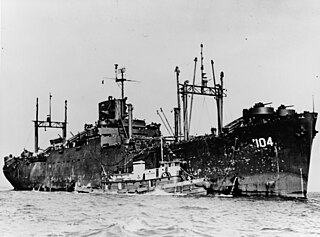
USS President Monroe (AP-104) was a President Jackson-class attack transport. that served with the US Navy during World War II. She was named after Founding Father and the fifth U.S. president, James Monroe.

SS Sea Marlin was a C3-S-A2 cargo ship operated for the War Shipping Administration (WSA) by Grace Lines during World War II. WSA allocated Sea Marlin to United States Army requirements. Sea Marlin was crewed by United States Merchant Marines, with a contingent of the US Naval Armed Guards for the guns and had a complement of the US Army Transportation Corps aboard for troop administration.

President Taylor was a cargo-liner, ex President Polk, ex Granite State, requisitioned for war service in December 1941 and allocated by the War Shipping Administration (WSA) to the U.S. Army and operating as a troopship in the Pacific Ocean in World War II when grounded and eventually lost on 14 February 1942.
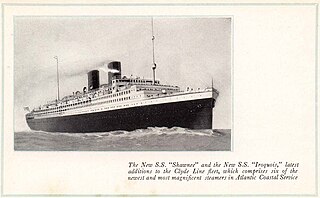
Shawnee was a passenger steam turbine-powered ship built in 1926-1927 by Newport News Ship Building & Drydock Co. of Newport News for Clyde Steamship Company, a subsidiary of Atlantic, Gulf & West Indies Steamship Lines with intention of operating between New York and southern ports of the United States. During the World War II the liner was requisitioned by the US Government, and served as the United States Army Transport from September 1942 to March 1946 in the Atlantic, Mediterranean and Pacific. Following the end of the war, the ship was sold to a Portuguese company and renamed City of Lisbon, and subsequently resold to Yugoslavia, becoming Partizanka operating with the shipping company Jugoslavenska Linijska Plovidba until 1949 when the steamer burned while in drydock and was declared a total loss.

SS Mormachawk was a United States cargo vessel and troop ship during the Second World War operated by Moore-McCormack Lines as agents of the War Shipping Administration (WSA) from completion 14 December 1942 until placed in reserve after the war September 1946. The ship remained in the Columbia River reserve fleet at Astoria, Oregon until sold for scrapping in 1964.
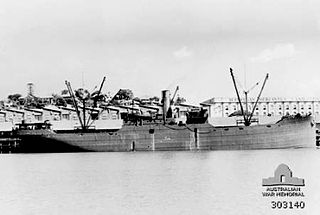
Coast Farmer, gaining the name in 1937 and previously bearing the names Point Arena (1928) and Riverside Bridge (1920), was a U.S. Shipping Board Emergency Fleet Corporation Design 1023 ship ordered under the name Minnewawa and built as hull #103 by Submarine Boat Company, Newark, New Jersey in 1920 Coast Farmer is noted as being a part of the Pensacola Convoy landing the supplies and troops intended for the Philippines in Darwin, Australia after being diverted on the news of the attack on Pearl Harbor. The ship became even more notable being the first of only three ships successfully running the Japanese blockade into the Philippines; leaving Brisbane February 1942. Coast Farmer was torpedoed and sunk off Jervis Bay, New South Wales on 20 July 1942.

Registan, built 1910, was the first name for a ship serving fifty years under the later names Guantanamo, USS Guantanamo (ID-1637), Comerio, Vittorin, Grey Lag and finally Hai Lung until scrapping in 1960. The ship transported gunpowder and munitions during World War I as USS Guantanamo and as a cargo ship during World War II for the War Shipping Administration (WSA). After 12 October 1943 the ship was assigned to the Southwest Pacific Area command's permanent local fleet as the United States Army transport Grey Lag with that fleet's number X-101. In April 1945 she was one of the transports towing large barges from Australia and New Guinea to the Philippines after that concept to mitigate shipping shortages had been proven feasible. In 1946 the ship was sold to the Republic of China and renamed Hai Lung.
SS Haiti was a passenger and freight ship built for the Colombian Mail Steamship Company built at Newport News Shipbuilding, Newport News, Virginia and delivered 15 December 1932. The ship was renamed briefly Puerto Rico in 1938 and Monterey in 1939 to operate for the New York and Cuba Mail Steamship Company until requisitioned with transfer of title to the War Shipping Administration (WSA) on 25 September 1942. The ship was then allocated to the U.S. Army for operation under a bareboat agreement as USAT Monterey. In 1943 the ship was assigned to the command at Trinidad to supply bases in Brazil and Ascension Island. After layup in the reserve fleet the ship was sold to Turkey.

SS Admiral Halstead was a merchant ship built in 1920 by the Submarine Boat Corporation, Newark, New Jersey, and operating originally as Suwordenco. The ship's history illustrates the state of the industry as the massive World War I shipbuilding program transitioned to an effort to sell and operate hulls in a market glutted by wartime shipbuilding. By the outbreak of World War II Suwordenco was one of the few ships operating as its owners went bankrupt. The ship was bought for operation from the Puget Sound to California ports until it was caught up in the prelude to the United States' entry into the war.

SS Rufus King was a standard Liberty ship built in the United States during World War II. She was named after Founding Father Rufus King, and was wrecked in July 1942, upon Amity Bar South of Moreton Island and north of North Stradbroke Island, Queensland, Australia. She was operated by International Freighting Corporation under charter with the Maritime Commission and War Shipping Administration.


















